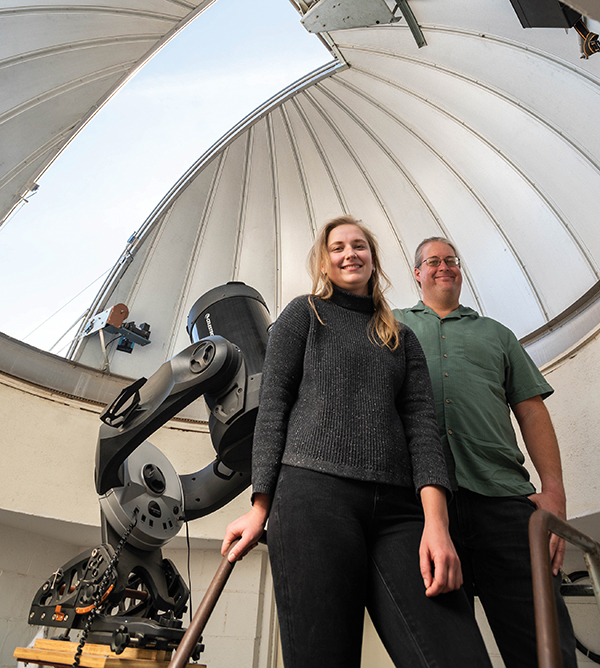NMSU Astronomy Professor Eric Nielsen and Ph.D. student Anne E. Peck are among the first researchers in the world to spot a newly discovered planet orbiting a star called AF Leporis. It is among the lightest exoplanets detected so far with the combined use of astrometric measurements and direct imaging.
“Annie and I look for planets around other stars using the direct imaging technique, where we take an image of the star and aim to detect light from an orbiting planet,” Nielsen says.
Nielsen and Peck worked with Robert De Rosa, a staff astronomer at the European Southern Observatory, which operates the Very Large Telescope in Chile. The team targeted stars that were candidate exoplanet hosts identified by astrometry, and confirmed AF Leporis b was a planet by directly imaging it with the Spectro-Polarimetric High-contrast Exoplanet REsearch (SPHERE) instrument at the VLT. By blocking light from the star, the planet was revealed.
“One of the great things about direct imaging is you actually see light from the planet next to the star,” Nielsen says, referring to the image taken with SPHERE.
The discovery has been accepted for publication in the “Astronomy & Astrophysics” journal; the paper is available online through ArXiV. At the same time, two other teams also identified AF Leporis as a candidate planet host and independently confirmed the planet via direct imaging observations.
“AF Leporis was identified as a candidate planet host using astrometry, where a star is observed to move on the sky due to an orbiting planet’s gravity,” Nielsen says. “The discovery was made possible by two European Space Agency space telescopes – Hipparcos and Gaia. Hipparcos made a precise measurement of the star’s position and motion in 1991, and its successor Gaia made new measurements in 2016 that showed the star’s velocity had changed in the intervening years. That told us something was orbiting AF Leporis – either a planet or another star.”
The NMSU team used the Apache Point Observatory’s 3.5-meter telescope, located in Sunspot, New Mexico, to take spectra of the host star and confirm that it was not another star creating the astrometric signal. Rather it was the orbiting planet detected in the SPHERE images.
The AF Leporis system shares similar features to Earth’s solar system. The star is only 20% more massive than the sun and the size of the planet’s orbit is similar to Saturn’s orbit around the sun.
“I think searching for planets with any method is exciting in that the science gives us a better context for our own solar system and our own planet,” Peck says. “We’re still far away from finding an exact analog, if there is one, but I think it provides a really interesting context for our own role in the universe.”
Nielsen says AF Leporis b is one of only a handful of planets to have been initially detected by astrometry and confirmed by imaging, “meaning we have a precise mass measurement and the planet’s spectrum, which allows us to study the composition and structure of their atmospheres.”
The newly discovered planet is about four times more massive than Jupiter, making it one of the lowest-mass planets detected by direct imaging so far.
“It’ll be interesting to see if there are more planets in the system besides AF Leporis b,” Nielsen says. “This isn’t the first time that astronomers have tried to find planets around AF Leporis with direct imaging and it’s a nice sign that just because you looked at a star once and didn’t see a planet, doesn’t mean that star is done. As technology improves and as you learn more information, it does make sense to come back and look for more.”

NMSU Ph.D. student Anne E. Peck (left) and Astronomy Professor Eric Nielsen are among the first to discover a planet orbiting the AF Leporis star.

Dove Hall, Room 212
305 N. Horseshoe Drive
Las Cruces, NM 88003